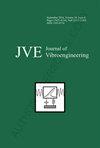非线性非对称减震器对受谐波激励的总线振动的影响
IF 0.9
Q4 ENGINEERING, MECHANICAL
引用次数: 0
摘要
本文的重点是全面了解四种不同类型减震器的特性及其对受到谐波激励的公共汽车垂直评估指标的影响。本文采用具有两个自由度(2DOF)的四分之一车模型来计算垂直评估指标。假定公交车以恒定速度在路面上行驶,路面轮廓为正弦函数。减震器有四种类型:线性对称(LS)、非线性对称(NS)、线性非对称(LA)和非线性非对称(NA)。LS 型的阻尼力是相对速度的线性函数,阻尼力在相对速度为正和负的条件下是对称的。与 LA 型相同,这意味着阻尼力是线性的,但它是不对称的,并根据悬架的冲程状态(压缩或拉伸)而有所区别。至于 NS 型,阻尼力函数是对称的、非线性的,根据相对速度的大小而不同。至于最后一种 NA 型,阻尼力函数也是非线性的,并根据相对速度的大小进行微分,但也是不对称的。在客车运行的常用频率范围 0 和 25(Hz)内,得到了客车悬架相对位移、车身加速度和轮胎动载荷的评价指标。结果表明,NA 型减震器能更有效地减小悬架的动态变形行程,改善路面保持力并保持乘坐舒适性。对减震器特性的系统评估应能指导感兴趣的读者选择最合适的阻尼系数。本文章由计算机程序翻译,如有差异,请以英文原文为准。
Influence of a nonlinear asymmetric shock absorber on vibration of a bus subjected to harmonic excitation
The main focus of paper is to get full understanding of four different types of shock absorbers characteristics and their effects on the vertical evaluation indexes of a bus subjected to harmonic excitation. The quarter car with two degree of freedom (2DOF) model was employed to calculate the vertical evaluation indexes. The bus is assumed to travel at a constant velocity on a road surface with a profile following a sinusoidal function. The four types of the shock absorber are Linear Symmetric (LS), Nonlinear Symmetric (NS), Linear Asymmetric (LA), and Nonlinear Asymmetric (NA). As for the LS type, the damping force is a linear function of the relative velocity, and the damping force is symmetric for the conditions of the positive and negative relative velocities. Same as for the LA type, it means that the damping force is linear, however it is asymmetric and differentiated according to the suspension state of stroke (compression or extension). As for the NS type, the damping force function is symmetric, nonlinear, differentiated according to the magnitude of the relative velocity. As for the last NA type, the damping force function is also nonlinear and differentiated according to the magnitude of the relative velocity, but it is also asymmetric. The obtained evaluation indexes of the relative displacement of the bus suspension, acceleration of the bus body, and the dynamic tire load within the frequency range of 0 and 25 (Hz), the common frequency range of the bus in operations. The results suggest that the NA shock absorber type is more effective in reducing the suspension dynamic deflection stroke, improving the road holding and maintaining the ride comfort. The systematic assessments of the shock absorber characteristics should guide interested readers in selecting the most appropriate damping coefficient.
求助全文
通过发布文献求助,成功后即可免费获取论文全文。
去求助
来源期刊

Journal of Vibroengineering
工程技术-工程:机械
CiteScore
1.70
自引率
0.00%
发文量
97
审稿时长
4.5 months
期刊介绍:
Journal of VIBROENGINEERING (JVE) ISSN 1392-8716 is a prestigious peer reviewed International Journal specializing in theoretical and practical aspects of Vibration Engineering. It is indexed in ESCI and other major databases. Published every 1.5 months (8 times yearly), the journal attracts attention from the International Engineering Community.
 求助内容:
求助内容: 应助结果提醒方式:
应助结果提醒方式:


